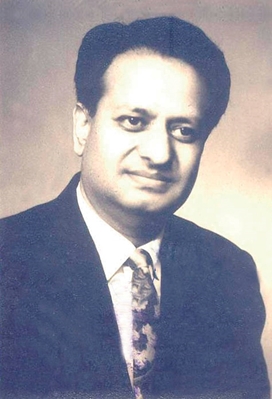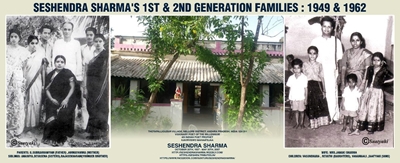Visionary Poet of the Millennium
An Indian poet Prophet
Seshendra Sharma
Kavirviswo Mahaatejaa
October 20th, 1927 - May 30th, 2007
Visionary Poet of the Millennium
Seshendra Sharma, a scholar - poet was born (October 20, 1927) into a Pujari ( Priests ) family in Nellore District in the state of Andhra Pradesh in India . Seshendra’s father and his grandfather were well versed in Sanskrit Literature, the Vedas, and the scriptures. At home itself, thus from his childhood, Seshendra got the opportunity of learning and training in Sanskrit. This was further nurtured by the Village school of Thotapalligudur, where he spent the best part of his childhood.
Seshendra’s father was a well-to-do person, a Munsif ( village officer ) of the village, possessing more than ten acres of agricultural wetland and his own house. His father’s desire to see his son flower into a top man turned a new leaf in Seshendra’s life. Seshendra’s father admitted him for B.A. Graduation course in Andhra Christian College in Guntur. Incidentally, Seshendra’s Family Sir Name and this town’s name are the same. This is a turning point in the budding poet’s journey. Seshendra where he got significant exposure to the Western World, particularly to Western Literature. The makings of a Visionary Poet germinated in him in this Alma Mater. His journey of poetry started with the Translation of Mathew Arnold’s “Sohrab and Rustum “ , a long poem, which Seshendra translated into Telugu in Metrical poetry with accomplished finesse. This trend eventually blossomed, and Seshendra emerged as an epic poet. His My Country – My People : Modern Indian Epic is observed by learned critics as a landmark in modern poetry, ranking it on par with T.S. Eliot’s Waste Land. This long poem was nominated for the Nobel Prize in 2004.

Seshendra’s desire to perform in films took him to Madras, today’s Chennai in Tamil Nadu. In Madras, he formally joined the B.L. Course at Madras Law College. And was developing contacts in the Telugu Cinema Circles and was working as a freelance journalist. He used to translate articles into Telugu for Janavani , a popular weekly of those times whose editor was Tapi Dharma Rao, a towering personality of Telugu Literature. This facet of journalism of his personality rose to its full heights in the 90s. When the Soviet Union collapsed, he wrote a series of articles in Telugu as well as in English, decrying the West’s sinister plot, villainous machinations to pull down Communist Regimes. He sang odes / laurels to communism and expressed in an aggressive tone and style that communism will never die. It remains in the genes of oppressed peoples of the world forever. Perhaps Seshendra is the only poet from the Indian Subcontinent to pen anti–imperialist essays during those times. He completed his Law course, but his desire to act in films remained unfulfilled. Seshendra’s Classmates at his Alma Mater, A.C.College, Guntur, N.T.Rama Rao and Kongara Jaggaiah became popular actors of Telugu Cinema. N.T.R became an all-time superhero. Seshendra’s father and maternal uncle forcibly brought him back from Madras, and with the good offices of a native Member of Parliament, put him in Government service as Deputy Panchayat Officer. In due course of time, on deputation, joined the Municipal Administration Department and worked as Municipal Commissioner in all Major cities and towns of Andhra Pradesh. With the result, he got wide exposure to the conditions of social life of his time. He obtained personal acquaintance with the Common Man’s life and his travails. This enriched his vision of life and literature a great deal.
With Seshendra, Poetry and Poetics are Siamese Twins. He penned works of Literary Criticism both on classical and contemporary poetry. Sahitya Kaumudi (Telugu ) and his bilingual book “The ARC of Blood: My Notebook “ illustrate this point. His Research work on Valmiki’s Ramayana , Shodasi : Secrets of The Ramayana , questions the very foundations of centuries-old assumptions. Seshendra, based on scientific research citing from the original text of Valmiki and Vedas, reveals that The Ramayana is not just a story of Rama told in enchanting poetry , But the Sage wrote the epic to spread Kundalini Yoga among the masses of his era. His observations that the concepts of Vishnu and Reincarnation were non–existent during Valmiki’s Epoch constitute a revolt against centuries-old beliefs. Sita is the central character of The Ramayana, and she is Kundalini Shakti / Adi Para Shakthi . During that era, temples and prayers were nonexistent. This hits directly at the very foundation of the Temple System.
His Kavisena manifesto is a noteworthy work on Modern Poetics. In this work, he compiles cogent definitions of poetry cutting across centuries and countries and writes scintillating commentary. This Manifesto of Modern Poetry is a sort of Wikipedia page of world poetry. Seshendra, finally concludes that poetry is emotions and feelings skilfully garbed in unusual diction, and poetry is a way of life.
Discerning scholars, critics, and academics are of the opinion that T.S.Eliot, Archibald MacLeish, and Seshendra Sharma are a trinity of world poetry and Poetics.
But this scholar–poet of the 20th century is an unsung genius of his times.
The Prime Minister of India honored Seshendra with a Gold Medal in Sahitya Akademi ( India ) Golden Jubilee celebrations, and the Chief Minister of AP honored him with the Hansa Literary Award on the eve of UGADI, Telugu New Year Day in 2005.
In one of his poems, he says the fragrance of stars is calling me. Seshendra left this world and vanished into the fragrance of galaxies on May 30, 2007.

* * * * * *
GunturuSeshendraSarma: an extraordinary poet-scholar. One of the ironies in literature is that he came to be known more as a critic than a poet
HYDERABAD: An era of scholastic excellence and poetic grandeur has come to an end in the passing away of GunturuSeshendraSarma, one of the foremost poets and critics in Telugu literature. His mastery over Western literature and Indian AlankaraSastra' gave his works a stunning imagery, unparalleled in modern Indian works. One of the ironies in literature is that he came to be known more as a critic than a poet. The Central SahityaAkademi award was conferred on him for his work KaalaRekha' and not for his poetic excellence. The genius in him made him explore Kundalini Yoga' in his treatise on Ramayana in Shodasi' convincingly. His intellectual quest further made him probe NaishadhaKaavya' in the backdrop of LalitaSahasraNaamavali', SoundaryaLahari' and Kama Kala Vilasam' in SwarnaHamsa', Seshendra saw the entire universe as a storehouse of images and signs to which imagination was to make value-addition. Like Stephene Mallarme who was considered a prophet of symbolism in French literature, SeshendraSarma too believed that art alone would survive in the universe along with poetry. He believed that the main vocation of human beings was to be artists and poets. His Kavisena Manifesto' gave a new direction to modern criticism making it a landmark work in poetics. Telugus would rue the intellectual impoverishment they suffered in maintaining a distance from him. Seshendra could have given us more, but we did not deserve it! The denial of the Jnanpeeth Award to him proves it.
The Hindu
India's National Newspaper
Friday, Jun 01, 2007
Page created on 1/16/2025 4:05:56 AM
Last edited 11/17/2025 11:44:28 AM
